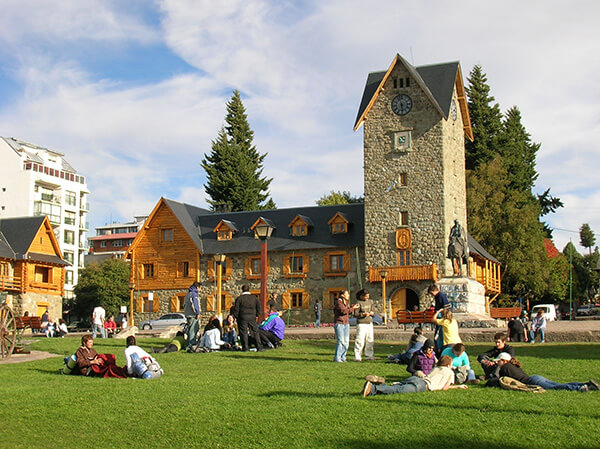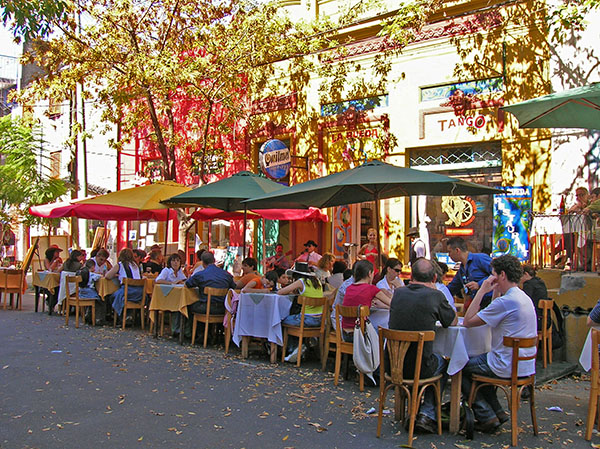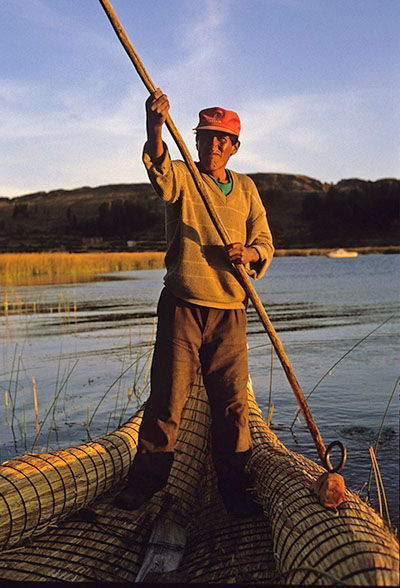The Guide to Learning Spanish in Latin America
Language Immersion Schools Are Most Effective
and Enjoyable
by Volker Poelzl
Resources updated 2/23/2024
by TransitionsAbroad.com

|
|
Bariloche, located in Argentina's Lake District, is a popular destination for travelers and language students. Photo ©Volker Poelzl. All Rights Reserved.
|
The vast region we call Latin America (including the Caribbean) has over 350 million Spanish speakers, surpassing the entire English-speaking population of the U.S. and Canada combined. With a rapidly growing Hispanic population and increasing economic ties with Latin America, Spanish is America's most important foreign language. Although widely taught in the U.S. at the high school and college level, the best way to study Spanish is to immerse yourself in the language by taking a learning vacation nearby. We are fortunate to have Latin America as a neighbor in North America. With 20 Spanish-speaking countries in the region, selecting the right location involves choosing from an overabundance of options. Diverse, adventurous, exciting, and meaningful language immersion learning and vacation programs exist for any taste.
8 Tips to Choose the Best Place to Learn Spanish in Latin America
1) Follow Your Interests and Priorities
To make the most of your Spanish study abroad experience, consider your interests, then connect them with practical considerations such as your budget and available time. Do you enjoy Peruvian music, Brazilian food, or Amazonian Guatemalan handicrafts? Why not study Spanish in Peru or Guatemala to learn more about the local culture? Have you always been interested in hiking in the Andes? Then, choose a South American country where the majestic Andean peaks are never far away. Do you want to see the jungle and watch wildlife? Costa Rica and Panama have a lot to offer in that regard. You can also head to Peru, Bolivia, or Ecuador — all offering a variety of nature parks that offer extraordinary experiences of rain forests and tropical savannas. If you've always wanted to visit Machu Picchu, take a Spanish course in Peru and hike up to the Inca ruins. Central America is the best choice if price is at the top of your priority list. Yet, suppose you really want to take tango lessons. In that case, you should spend the extra money and study Spanish in Argentina.
Any Latin American country you have visited and enjoyed is also a good candidate for a language immersion program since you already know what to expect culturally and what hospitality you will enjoy.

|
|
Buenos Aires has a vibrant street life. Photo ©Volker Poelzl. All Rights Reserved.
|
2) What is Your Budget?
If cost is an issue, keep in mind a few factors. In addition to the course fee, you must set aside some cash for room and board, entertainment, and excursions. The course fees and living expenses are lower in less developed countries. Nonetheless, sometimes economic crises and currency devaluations can lower your expenses dramatically, even in countries that once had a high cost of living. Argentina's peso was pegged to the dollar one-to-one until a monetary crisis forced the government to drastically devalue the peso in early 2002. Within a few months due to economic issues, the U.S. dollar was worth almost many times as much. The peso continues to radically fluctuate in value due to inflation, which is one of the reasons why Argentina has often been a popular and affordable destination for Americans and others international visitors.
Airline tickets represent a decent chunk of change for a Spanish course abroad. No matter how many travel websites and agents tout cheap airline tickets, airfare prices usually rise. You reduce travel expenses by selecting a country closer to home for your Spanish study. A ticket to Central America usually costs half as much as a ticket to South America. Still, ticket prices vary considerably between airlines and even the day of the week you fly. By carefully researching and comparing prices, you can save significantly. For example, a flight with an additional stopover can be cheaper than a direct flight. Determining baggage weight limits and carefully packing your things will also help you prevent surcharges.
Another cost factor is the location within the country you choose. Capitals and large cities usually have higher course fees and cost of living than small towns. Popular tourist centers are generally more expensive than lesser-known destinations. Also, consider the overall cost if you plan to travel after completing your language course. Traveling long distances in large countries, such as Mexico, Chile, or Argentina, will cost more than traveling in geographically smaller Costa Rica or Panama.
3) How to Choose the Right School for Language Learning?
So many ways now exist to search for a language school that meets your needs and more!
-
Conduct an online search using your favorite search engine. You will find websites offering a variety of language learning options to choose from, along with first-hand stories and reviews.
-
Seek out a wide selection of language schools in countries in Latin America, some of them small and locally owned, others part of a more extensive network of global affiliation.
-
Check out online networks of Spanish schools in several countries. This can be a good indicator of a school's quality. The teaching curriculum is usually identical in all affiliated schools, and the teaching materials and methods have been tested to maximize the student's progress.
-
Contact local schools directly to book your course. Directly booking your program is generally cheaper, but it has the disadvantage that you need recommendations about the quality of the language school.
-
Book with a reputable placement agency in the U.S., with the advantage that many offer a satisfaction guarantee.
-
Please check out the school's operating history, teaching methods, and qualifications. Since no "Teaching Spanish as a Second Language" certificate corresponds to the TEFL certification (Teaching English as a Foreign Language), each school has its own criteria for choosing qualified teachers.
-
Look up the teachers' credentials. Some schools require a master's degree in education from their teachers, but this depends on each school. Although English is usually not spoken during class, it is helpful if the teachers speak some English so you can ask them specific questions after class.
-
Research the school before you pay for your classes to choose a high-quality program that fits your needs. Go to forums and ask questions, browse review sites, and contact school alums to receive first-hand information. Any good language school will allow you to contact alums since they should have nothing to hide. The more alums you speak to, the better. Try to raise polite, probing questions before making your language school choice.
Before making a choice—or choices for more than one school in more than one country—it would be prudent to compare schools and find details about the instruction and the policies.
-
How many hours of instruction do you get per week?
-
What are the class sizes?
-
Does a school refer you to homestays, or must you find room and board independently? Staying in a homestay with a local family enhances your language learning and cultural experience.
-
What are the cancellation and refund policies, and does the school offer a satisfaction guarantee?
-
What other services does your school offer, such as airport pickup, cultural events, and excursions?
Due to the competition for students and the pride many of those working in language schools have in their land and culture, it is common for programs to offer excursions to nearby sites of interest and adventures to balance time spent in the classroom. Find out if the school provides such expeditions if you are interested. In addition, some schools offer a combination of language learning and activities such as traditional dance, music, cooking, handicrafts, art, and even surfing. Extra activities may involve additional costs, such as samba lessons at a school in Brazil.
Many Latin American countries suffer from poverty and social inequalities, and there is now an increasing number of language schools that combine volunteer work with language learning. Volunteering is a significant way to improve your Spanish, become immersed in the local culture, and decide the skills you can offer to help improve the living conditions of locals. Do you have carpentry, nursing, computer, or other skills you wish to share?

|
Cusco, Peru, offers a great combination of the Inca and Spanish cultural heritage.
Photo ©Volker Poelzl. All Rights Reserved.
|
4) How Long will you be Studying or Vacationing?
Your language learning goals should determine the length of the course you take. Are you a beginner who wants to pick up the language intensely, or have you studied Spanish before and want to brush up your conversation skills through immersion? To receive the long-term benefits from a Spanish course, I recommend sticking with it for at least 2-3 weeks. For beginners, this is long enough to immerse you in the language and culture of your host country, meet the local people, and gain some basic conversation skills. But remember that language acquisition only happens after some time. You will have to set aside time for practice and study if you really want to make progress.
Don't expect miracles from an intensive course. Learning a foreign language takes time, and not even a super-intensive course can substitute for the time necessary to study grammar and vocabulary. On a yearlong student exchange in Brazil, I decided not to study vocabulary since I believed it would come naturally over an academic year. However, most students who take a much shorter language course don't have the luxury of hearing a word ten times before they grasp its meaning. Vocabulary study is your primary tool for improving your Spanish skills, and you can memorize only so many words daily. So, have realistic expectations. If you have the time and the money, studying Spanish abroad for a month will significantly enhance your skills as a beginner, and two or three weeks will be enough to boost the skills of someone with some previous knowledge of Spanish.
5) How Diverse is the Destination Culture?
What makes language learning abroad enjoyable in the region is lively interaction with locals and immersion in their culture. Some Latin American countries are more culturally diverse, and some have more deeply rooted local traditions. You can choose among countries with European or indigenous traditions or one where the culture of Spanish colonizers has blended with the indigenous culture to form a unique blend. Guatemala, Ecuador, Peru, and Bolivia have robust indigenous cultural roots, making them fascinating and colorful places to visit. On the other hand, the African and Caribbean heritage of the Dominican Republic and Cuba create a rich and lively culture in different ways. Argentina and Chile, on the other hand, are more European but still have uniquely local traditions. The way of life of the gaucho, as cattle herders are known in Argentina, is a unique tradition that has contributed to the national identity. Similarly, the Andean cultures in Ecuador, Peru, and Bolivia draw on their vast heritage from the Inca Empire, and many age-old traditions are still widely practiced.

|
Many traditions and ways of life are still alive in Bolivia.
Photo ©Volker Poelzl. All Rights Reserved.
|
6) Health, Safety, and Comfort Considerations
Feeling comfortable and safe in your host country is an important consideration. Regardless, such thoughts should not become exaggerated in your mind. True, most Latin American countries have gone through dark periods, and the legacy of decades of dictatorships can be felt across the continent. Drug traffickers operate in Latin America, especially in Central America. They are often responsible for kidnappings and a general increase in crime. However, many stories are sensationalized by commercial media, and the images projected often do not reflect the daily peace of everyday life in many parts of every country.
Language students and long-term travelers should nevertheless carefully research the political and economic stability of the country and cities where they plan to stay. Fortunately, fewer Latin American countries have rampant inflation or severe economic crises than in the past. Yet, poverty indeed does exist and can contribute to periods of civil unrest, demonstrations, and strikes. Like those who follow the news too much, you can't let such images in the commercial media prevent you from living your life.
Suppose you have health concerns about some exotic diseases in tropical America. Consider a country with a cooler climate, such as Argentina or Chile, or a higher elevation, such as the high plateaux in Ecuador, Peru, and Bolivia, where mosquito- and insect-borne diseases are rare. Nevertheless, if you get vaccinations for Hepatitis, yellow fever, typhoid fever, and tetanus, you should be safe. If you take standard health precautions, eat only peeled or sanitized vegetables and fruit, and only drink bottled water, you will avoid the most common health problems that affect foreign visitors. Malaria is another primary health concern for foreign visitors to tropical America. Concerned travelers should ask their doctor about taking prophylactic medication in Latin America. Malaria is more likely to occur in rural areas of the humid tropics but is rare in urban areas. Some countries in Central and South America are disaster-prone, with regular hurricanes, earthquakes, and even volcanic eruptions. Find out beforehand how safe your potential destination is from these threats, but as a point of reference, remember that anything can also happen in San Francisco, New York, New Orleans, Miami, and Texas.
Your host country's development level may also be an essential consideration. If you are accustomed to a high standard of living and comforts, consider one of Latin America's wealthier and more developed countries, such as Mexico, Costa Rica, Panama, Argentina, or Chile. For example, running water may only be available intermittently in remote or developing areas. In humid tropical regions, your host family may not have a hot shower, air conditioning, or fans, and it may take some time to get used to the heat. But "when in Rome," think travelers with a sense of adventure and desire to explore something new and authentic.
Another question you should ask yourself is how well you can handle cultural differences and an unfamiliar way of life. Do you seek the exotic or the familiar? Are you used to challenging yourself with new and unknown cultures, customs, food, and experiences? Or do you prefer to advance cautiously and first experience cultures closer to yours? Latin America's more developed countries, such as Mexico, Chile, and Argentina, offer an urban standard of living comparable to North America.
7) How Important is Being Near Nature?
After weeks of classroom attendance, students' most rewarding experience is traveling around the host country before returning home. Depending on your choice, you can experience some of the most incredible travel destinations in all the Americas. While visiting steaming jungles and smoking volcanoes will not improve your Spanish, consider what your country of choice offers in terms of natural attractions and travel destinations.
You may enjoy hiking and trekking in high altitudes. In that case, Central America has little to offer compared to South America, with its majestic mountain ranges. Conversely, Central America has fantastic jungle environments and beautiful Mayan ruins surrounded by rainforests. Or you love to relax on a beach. In that case, Central America is the way to go, offering you a wealth of choices between Caribbean and Pacific beaches. In Central America, most countries are small, and national parks are ubiquitous. South America, on the other hand, is vast. Getting to your favorite outdoor destination may take several days. I don't suggest that you base the destination of your language learning only on a country's natural attractions. However, selecting a region that best meets your travel interests can provide a memorable climax to your stay abroad.
8) How to Choose an Appropriate Location in a Country?
Large urban centers in Latin America generally represent the best and the worst these countries offer. In general, capital cities and large metropolitan areas have some disadvantages. Cities are usually where the most wealth and the most significant poverty are concentrated. Impoverished peasants from the countryside are attracted to large cities due to material promises. Nevertheless, many may end up in shantytowns. A higher crime rate sometimes reflects enormous social discrepancies among the population. Urban crime in the largest cities raises fear among the locals and can make them less outgoing and willing to meet strangers.
On the other hand, studying Spanish in a large city may be your best choice if you love urban culture and entertainment. You will find trendy restaurants and clubs, art house movie theaters, dozens of museums, art galleries, and plenty of other entertainment options—not much different from the pros and cons of living in New York or Chicago. Language students who are not experienced and "street-smart" travelers would be wise to consider other options.
Smaller cities offer a better quality of life. They are generally not nearly as prone to crime as large urban centers. Regional culture is also usually more lively outside of the capitals, and students and travelers are more likely to meet local people. Smaller cities maintain a lower cost of living, are generally safer, and the people are usually friendlier than in large cities. A small town's colonial or historical flair is often more attractive than a modern urban center. Such travel and study choices depend primarily on your personal preferences and experience.
Keep in mind that Central America offers many destinations that are popular with American tourists. Although Costa Rica, Guatemala, and Panama rank among the most beautiful destinations in the region, you may need help to practice your Spanish since locals are used to English-speaking visitors. The farther you get away from the U.S., the greater your chances to have a truly authentic experience of the local people and their culture. In South America, there are just a few destinations where American travelers or expatriates tend to congregate, which increases your chance to practice Spanish in your daily affairs and interactions. For example, Costa Rica welcomes 600,000 American tourists every year. By comparison, Argentina is 55 times larger, has 9 times the population of Costa Rica, and only hosts 300,000 American visitors annually. Locals understandably tend to be more friendly, welcoming, curious, and genuinely interested in meeting foreigners in areas with fewer tourists.
Consider some of these suggestions and take a little time researching several countries and schools. If you do, your language course or vacation in Latin America will likely be a memorable and rewarding experience and change your life. You may find yourself lured back like a traditional Spanish folk tune.
Latin American Language Learning Info
Language Schools in Latin America is an extensive listing of Spanish schools all across Latin America.
Family-Friendly Spanish Schools in Latin America
Language School Hopping: Study Spanish Across Central America
Top Mountain Towns to Study Spanish in Latin America and Spain
Below is a short list of the pros and cons of learning Spanish in various Latin American countries, with links to articles and resources:
Mexico
Pros: It is close to the U.S., relatively well-developed with good infrastructure, a large country with a wealth of fantastic destinations for language learning, a diverse culture and ecosystem, not as cheap as Central America, but still affordable, and low airfares from the U.S. Mexico City is now one of the most interesting and exciting cities in the world.
Cons: Regional social unrest, petty crime, and drug trafficking in specific locations; many attractive areas are very popular with American tourists and expatriates, so learning Spanish can be more difficult.
More Articles and Resources about Learning Spanish in Mexico:
Study Spanish Language at Schools in Mexico
Perfecting Language Skills at the Instituto Cultural in Oaxaca
Spanish Language Learning in Oaxaca, Mexico Through the Senses
Costa Rica
Pros: It is a largely well-developed country with many national parks and incredible natural beauty, a good network of Spanish schools, relatively safe, lesser health risks, and lower airfares from the U.S.
Cons: Culturally less diverse than other Central American countries; a very popular tourist destination with a significant North American presence.
More Articles and Resources on Learning Spanish in Costa Rica:
Study Spanish at Language Schools in Costa Rica
Spanish Language Learning in Laid-Back Costa Rica
Nicaragua
Pros: Diverse culture and ecosystem; very affordable, growing tourism infrastructure; low airfares from the U.S.
Cons: Poorest Central American country and therefore less developed; earthquake-prone.
Language Learning in Nicaragua: Choose from Central America’s Best Bargains
Panama
Pros: Panama has the largest tropical forest in Central America and a diverse environment, including the Pacific and Caribbean coast, rainforest, and mountains. It is moderately well-developed with adequate infrastructure and is safe, but tropical diseases are present. The U.S. dollar is Panama's paper currency, so you won't have to deal with foreign exchange for affordable airfares from the U.S.
Cons: Strong U.S. influence makes Panama a less attractive popular tourist destination for some.
More Articles and Resources: Study Spanish at Language Schools in Panama
Guatemala
Pros: Great Mayan heritage and strong indigenous cultural traditions; low-cost destination; a spectacular lake and many volcano ranges; low airfares from the U.S.
Cons: Poorly developed, increasing crime rate, and drug trafficking.
More Resources:
Study Spanish at Language Schools in Guatemala
Ecuador
Pros: Diverse ecosystem; rich cultural heritage and indigenous culture; the U.S. dollar is the currency of Ecuador, so you won't have to deal with foreign exchange; relatively safe; very affordable; cheapest airfares in South America from the U.S.
Cons: Frequent civil unrest, economic and political instability, poorly developed, rudimentary infrastructure, and health risks at lower elevations.
More Articles and Resources for Learning Spanish in Ecuador:
Study at Spanish Language Schools in Ecuador
Study in Ecuador: Quito's Spanish Language Schools are Many and Affordable
Vacations in Ecuador: Combine Language Immersion with Ecotourism
Peru
Pros: Popular travel destination with rich cultural traditions and great historical heritage, diverse ecosystem, low cost; reasonably safe, but with health risks in tropical lowlands.
Cons: The area needs to be better developed outside urban areas, which can make travel difficult; most language schools are located in popular tourist destinations; and the cost of air travel from the U.S.
More Articles and Resources on Learning Spanish in Peru:
Study Spanish at Language Schools in Peru
Enjoy a Taste of Spanish in Cusco, Peru: Language Learning and Cultural Immersion
Study Spanish in Arequipa, Peru: A Warm School in a Warm City
Chile
Pros: European cultural influences are surprising, with some indigenous traditions; well-developed with good infrastructure, safe with low health risk; spectacular and diverse scenery in this long country, and a mix of mountain and ocean environments.
Cons: Higher cost of air travel from the U.S.; higher cost of living than other Latin American countries; relatively cool and damp climate.
More Articles and Resources:
Study Spanish at Language Schools in Chile
Argentina
Pros: Well-developed, rich culture, friendly people, a vast country with diverse culture and natural environment; safe, low health risk.
Cons: The higher cost of air travel from the U.S. and the higher cost of living than other Latin American countries. Locals can be a bit aggressive, especially in Buenos Aires.
More Articles and Resources:
Study Spanish at Language Schools in Argentina
Bolivia
Pros: Great cultural heritage and rich indigenous traditions; diverse ecosystem — from the Amazon basin to high peaks in the Andes; low-cost destination; reasonably safe, but with some health risks in lower elevations.
Cons: The higher cost of air travel from the U.S. and the higher cost of living than other Latin American countries.
Recommended cities: Sucre, Cochabamba.
Note: Please see our individual country directories for many excellent Spanish language schools in Latin America.
|
Volker Poelzl is a Living Abroad Contributing Editor for TransitionsAbroad.com. A travel writer fluent in five languages, he writes about Language Learning and cultural immersion.
|
